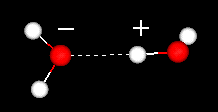|
Why is water such a good solvent?
| Note
about 3D molecules -- Our files on this page now
use Jsmol instead of Jmol. These files
make use of Javascript which permits viewing of
molecules on tablets, phones and easier use on
Macs. - Jsmol is best viewed with the Chrome browser.
For the water_jmol file. |
|
To rotate click left
mouse button over the java applet image and drag cursor.
Zoom with middle button...
Try changing to CPK -- Click
right mouse button in box--->
Style-->Scheme -->CPK
Use left mouse button to rotate
[Right mouse button for more Options]
|
| A
water
molecule is formed when two atoms of hydrogen bond
covalently with an atom of oxygen. In a covalent bond
electrons are shared between atoms. In water the sharing
is not equal. The oxygen atom attracts the electrons
more strongly than the hydrogen. This gives water an
asymmetrical distribution of charge. Molecules that
have ends with partial negative and positive charges
are known as polar molecules. It is this polar property
that allows water to separate polar solute molecules
and explains why water can dissolve so many substances.
|
|
|
Water
is a good solvent due to its polarity. The solvent properties
of water are vital in biology, because many biochemical
reactions take place only within aqueous solutions
When
an ionic or polar compound enters water, it is surrounded
by water molecules. The relatively small size of water molecules
typically allows many water molecules to surround one molecule
of solute. The partially negative dipoles of the water are
attracted to positively charged components of the solute,
and vice versa for the positive dipoles.
An example
of an ionic solute is table salt.
| 
|
Liquid
water has a partially ordered structure in which hydrogen
bonds are constantly being formed and breaking
up. |
The
strong hydrogen bonds also give water a high cohesiveness
and, consequently, surface tension. This is evident when
small quantities of water are put onto a nonsoluble surface
and the water stays together as drops.
|
What is the
distance in angstroms for the hydrogen bond shown above?
|
[Water
Molecule is shown using the Jsmol] |
To
measure distance
Label
Atoms
Style
--> Labels
Right
mouse button -->Measurements -->
Double
click on hydrogen (H31) then drag to oxygen (O28) -- double
click again
To
measure distance Double
click on one atom then drag to second atom-- double click
again
To measure
angles
Double
click on first atom, once on middle atom, twice on atom three. |
|
|
1)
What is the distance of the hydrogen bond show?
Please
enter your answer in the space provided:
2) What
is the measure of the HOH angle in a single molecule of water?
3)What is distance between the oxygen atoms in a water dimer?

